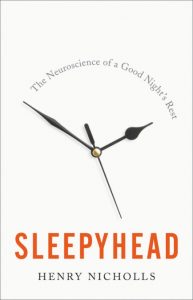 This week, we turn to a science book that proved to be utterly fascinating. This week, we turn to Sleepyhead by British science journalist Henry Nicholls.
This week, we turn to a science book that proved to be utterly fascinating. This week, we turn to Sleepyhead by British science journalist Henry Nicholls.
As we find out at the very beginning of this book, Nicholls has a very personal reason for looking into the science of sleep and sleep disorders – he himself is narcoleptic. And his own narcolepsy becomes the narrative that ties the entire book together.
In this extremely well researched book – the last 24% of the book is nothing but bibliography and index -, we get a personal and scientific look at narcolepsy, its origins, discovery, scientific basis, and personal effects. We also get an examination of several other sleep disorders, including sleep apnea, phase disorder, and the feeling of being awake yet unable to move. We learn what scientists consider to be the causes of each, their effects, and how to attempt to manage them.
We also learn about the scientific reasoning for some of the general “better sleep” tips most of us have heard at some point – be careful with artificial lighting, caffeine, nicotine, and alcohol. Indeed, the second chapter is all about the effect light has on the circadian rhythm and the chemical processes that control it. That said, DO NOT go into this book expecting a quick tip or two about how to get better sleep – you’ll get that, but it will be as a part of the scientific explanation behind that piece of advice.
Overall, this is truly a fascinating, approachable look at the science of something many of us barely actually consider – how exactly sleep works, why it is necessary, and how to try to get the best sleep possible. Very highly recommended.
As always, the Goodreads/ Amazon review followed by the newer feature, the YouTube review!
The Science of Sleep. As told by a narcoleptic journalist. This was actually a fascinating book about the hard science of sleep – all the way to the gene and chromosome level of certain sleep disorders. Other than the first chapter and last chapter, the traditional setup and summary, the remaining 10 chapters cover the hard science of sleep – everything from how light plays a large part in our circadian rhythm cycles to exactly how the current thinking on most sleep disorders was discovered by studying dogs. The *one* caution here is that if you come in looking for a quick pointer or two on how to sleep better… well, you’ll get that. But you’ll get the hard science explanation of *why* it is, rather than a short and sweet “do this, just do it”. Excellent book, very thoroughly researched – the last 24% or so is bibliography and index!
